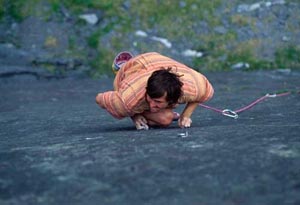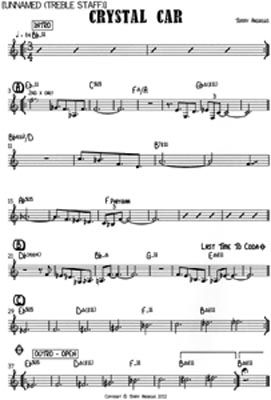 that I’d try and write something that fitted on to one sheet of A4 and was concerned solely with creating a strong melody. With no real ballads in the set I decided that I’d try and write something that was quiet, luscious and simple.
that I’d try and write something that fitted on to one sheet of A4 and was concerned solely with creating a strong melody. With no real ballads in the set I decided that I’d try and write something that was quiet, luscious and simple. Crystal Car
[Your computer might ask you to allow the music to play on this page]
In 2014, the Tommy Andrews Quintet released their successful debut album The Crux. Tommy talks about one of the tracks, Crystal Car and its place in the album:
During the early stages of the quintet’s life, a lot of the tunes were lengthy and complicated in some way. I therefore promised myself  that I’d try and write something that fitted on to one sheet of A4 and was concerned solely with creating a strong melody. With no real ballads in the set I decided that I’d try and write something that was quiet, luscious and simple.
that I’d try and write something that fitted on to one sheet of A4 and was concerned solely with creating a strong melody. With no real ballads in the set I decided that I’d try and write something that was quiet, luscious and simple.
After the first few gigs that we played, I listened back to some of the recordings and found that there were areas in the tunes that could potentially become a wash of information with no aural ‘handrails’ for the listener to follow. Due to this, I am now always keen to place elements within a piece that act as a constant, to help keep a sense of cohesion and glue everything together. If you listen to my first album, you’ll spot these devices everywhere. In The Crux it’s firstly the motivic anticipations in the melody and then the held Gb through a long chord progression in the second section. Sirens has the slowly evolving osinato piano part, Mr. Skinny Legs has strong motifs in the melody and then a rhythmic figure that stays constant during the morph from simple to compound time. L.H.B. takes an identical piano rhythm through a metric modulation and Steep is held together by its repetitive bass riff. For an exercise in creating something simple, however, I opted to try and use a harmonic device rather than any metric modulations or rhythmically complicated. The result was Crystal Car.
Due to the fragile nature of the ballad, I was drawn to a quote from British rock climbing legend and racing enthusiast Johnny Dawes’  autobiography Full of Myself. This was written after the first ascent of the Indian Face in 1986, a climb on the Clogwyn d’ur Arddu in Snowdonia. At the time it was the most technical, imaginative and tenuous rock climb in the world, and nearly 30 years later has rarely been repeated or surpassed. Johnny was a true visionary on the rock, accepting risks as part of putting his artistry first.
autobiography Full of Myself. This was written after the first ascent of the Indian Face in 1986, a climb on the Clogwyn d’ur Arddu in Snowdonia. At the time it was the most technical, imaginative and tenuous rock climb in the world, and nearly 30 years later has rarely been repeated or surpassed. Johnny was a true visionary on the rock, accepting risks as part of putting his artistry first.
‘A week after the ascent The Guardian ran a double page spread: Indian Face. For a day, climbing had the oomph to squeeze Nigel Mansell and Gary Kasparov to single columns. The public could not be expected to understand fully, probably thinking the climb merely scary, tricky, not the equivalent of racing a crystal decanter car around Monaco.’
Johnny Dawes
I instantly enjoyed the image of this ‘Crystal Car’ bombing around the narrow streets of Monaco, where one mistake would ultimately spell death to the driver. It perfectly described Johnny’s position, where a slip would be fatal. I also enjoyed his little poke at the public. It mirrors the occasional feeling you can receive as a musician, where after playing something particularly challenging it’s possible that no one will ever comprehend quite how much of your life’s experience went into that one moment!
 A+B: If you listen carefully when the sax enters and the bass has finished playing the tune, you’ll hear that the root notes of all the chords are constantly falling in 3rds. I change between minor 3rd intervals and major 3rd intervals in the bass to explore how they affect the brightness or darkness of each harmonic shift. The resolution to a Dbadd4 chord after 4 bars on a tense F Phrygian chord is the main resolution of the tune. The warmth of a Db major chord, especially with an added fourth degree, can be extremely attractive, and you’ll find that it features in many of my tunes when I need to give some comfort to the listener!
A+B: If you listen carefully when the sax enters and the bass has finished playing the tune, you’ll hear that the root notes of all the chords are constantly falling in 3rds. I change between minor 3rd intervals and major 3rd intervals in the bass to explore how they affect the brightness or darkness of each harmonic shift. The resolution to a Dbadd4 chord after 4 bars on a tense F Phrygian chord is the main resolution of the tune. The warmth of a Db major chord, especially with an added fourth degree, can be extremely attractive, and you’ll find that it features in many of my tunes when I need to give some comfort to the listener!
C: To then stop the piece from seeming like it’s falling into a cycle of descent, the last 8 bars use a rising melody and more rising chords to take it back whence it came.
It’s thus possible to loop A, B + C if there were to be repeats of the tune and solos, or just head to C after the head as we do on the album for a more collective approach. The cycling of the whole tune brings more melancholy through the descending chords and starting minor chord, whereas the rising nature of the last 8 bars and use of a suspended starting chord seems to bring more promise if it’s looped.
Lead Sheet for Crystal Car © Tommy Andrews
You’ll notice the climbing term ‘The Crux’ and a musical reference as Johnny Dawes recalls the hardest section of the ascent in his autobiography.
‘I went for the crux, the motion startling me like a car unexpectedly in gear in a crowded parking lot. I swarm through the roundness of the bulge to a crank on a brittle spike for a cluster of three crystals on the right; each finger crucial and separate like the keys for a piano chord. I change feet three times to rest my lower legs, each time having to jump my foot out to put the other in. The finger-holds are too poor to hang on should the toes catch on each other. All those foot-changing mistakes on easy moves by runners come to mind. There is no resting. I must go and climb for the top. I swarm up towards the sunlight, gasping for air. A brittle hold stays under mistreatment and then I really blow it. Fearful of a smear on now-non-sticky boots I use an edge and move up, a fall fatal, but the automaton stabs back through, wobbling, but giving its all and I grasp a large sidepull and tube upward. The ropes dangle uselessly from my waist. I grasp incuts and the tight movement swerves to a glide as gravity swings skyward.’
Johnny Dawes, Full of Myself, 2011.
Tommy Andrews
Saxophones, Woodwinds, Composer, Arranger and Teacher www.tommy-andrews.co.uk
Click here for more details about The Crux album and to taste the other tracks. Click here for our profile of Tommy Andrews.
Visit our other Full Focus pages:
Alec Harper: Beaker
Dave Maningon's Riff Raff: Agile